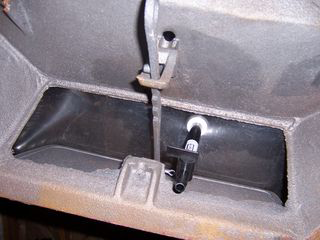
by blogediter | May 24, 2019 | Fireplaces
Q: Do I close the chimney damper after installing the Chimney Balloon?- JJ
A: Dear JJ, There is no need to close the damper below your Chimney Balloon. The Chimney Balloon is doing the job of the damper and quite frankly it is doing a better job than the metal damper could anyway. So closing the damper after the Chimney balloon is installed is like closing a screen door on the inside of a submarine.
However, You can have the damper closed if you have the Chimney Balloon in there far enough to close it. There are a few things to keep in mind though if you do decide to close the damper. If you try to force the damper closed it may put upward pressure on the valve section of your Chimney Balloon. That is a little tough on your Chimney Balloon since it puts undue pressure on the valve and Chimney Balloon.
The other issue is if you close your damper you may forget you installed the Chimney Balloon and just open the damper and start a fire.
Personally, I leave my damper open and leave the inflation tube attached, so it dangles just above my head when I open the glass doors to the fireplace. With this solution, I still have no draft problem and I haven’t accidentally melted a Chimney Balloon yet. – Jason
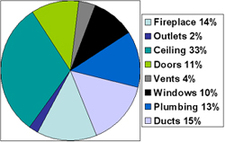
by blogediter | Apr 22, 2019 | Chimney Plugs
Q: Jason – I see in some places on the chimney balloon website and in literature you state that a Chimney Balloon can save a homeowner $200 in home heat. How do you get that figure? – JP
A: Dear JP, I’m glad you ask this. A person should always challenge marketing claims of any product. Lets take a look at what the Department of Energy, the Energy Information Administration, and some independent studies say…
Open or Missing Fireplace Dampers:
A European research study titled “Ventilation perturbations due to an open fireplace in a house” – by P. Dalicieux and C. Nicolas concluded that a missing or left open fireplace damper can result in a home to have a 30% increase in heating costs. The US Energy Information Administration said that in 2005-2006 the average US family spent $1044 on home heating bills. This information is on their 2005-2006 report. So 30% of $1044 is $313. Keep in mind this is 2005-2006 information and energy cost trends have home heating cost increasing 25%-30% each year since then. As you can see, $313 is more than our more conservative statement about $200 in savings using a Chimney Balloon. But, lets look at another study…
Fireplace Dampers That are Functional or Damaged:
The Department of Energy (DOE) states that 14% of a homes heat loss is lost through the fireplace even when there is a damper in the fireplace. They also say the average family in 2005 spends $1600 per year on utility bills. Personally, I think this figure is low. I live in a tight 1100 sq ft ranch (with new power vent furnace and water heater) and I know I spent more than $2000 on utilities in 2007, but I suppose the DOE is figuring in the North and South US climates together.
So if we spend the $1044 per year on home heat that the (The US Energy Information Administration says we spend) and 14% goes up the fireplace flue, then the person is loosing $146 in home heat per year even if you have a functional damper.
So with these two studies we take the average between the two to be $230 in home heat. That is where we get our $200 in heat savings. I hope you can pardon us for rounding down on the final figure. – Jason
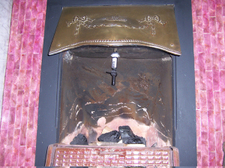
by blogediter | Apr 8, 2019 | Chimney Plugs
Q: Jason – I have a decision to make. I can either pay a chimney sweep $950 to replace my metal flue damper or I can just have him clean the chimney and buy a Chimney Balloon. Which one should I do? – TR
A: TR – Well to be honest with you $950 sounds like a rather large amount to replace a metal damper, I hope he including a chimney cleaning with that quote. I am of course assuming that your fireplace is of a standard make & size. If your chimney required a custom fabricated damper it would be much more expensive and would have been obvious from the quote.
The answer to this question lies almost entirely in two questions …How often do you use your fireplace? And how concerned are you with conserving your homes heat?
If you use your fireplace less than once a week on average you would certainly be better off just going for a chimney cleaning and a Chimney Balloon. In this case you are an occasional user of your fireplace and it spends much more time out of use than in use. You want as tight of a seal on your fireplace flue as possible to maximize heat savings and minimize chimney creosote smell.
If you use your fireplace more often than once a week on average you probably are not that concerned about loosing heat from your home since fireplaces tend to waste much more heat than they create for your home. The US Department of Energy states that regular use of an open fireplace will actually increase your heating bill. The major point of the Chimney Balloon is that is saves heat, not that it is easier to use than a damper.
So in this case you want to consider replacing the metal damper. You will get an inferior seal on you flue with a metal damper, but it will more convenient for you to use than a Chimney Balloon. As it is, most homeowners forget to close their damper after having a fire, and you may grow weary of installing and uninstalling your Chimney Balloon and some day you will just stop using it.
TR, I could give you a pat answer that “Of course the Chimney Balloon is your best option!!” but I think you will appreciate seeing it from both sides. – Jason
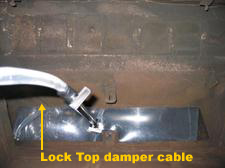
by blogediter | Apr 3, 2019 | Chimney Plugs
Q: I have a top sealing damper, and I still get a draft from my fireplace. It cost me $550 to get the chimney top damper put on my chimney and it only half solved the problem. Will a $50 Chimney Balloon stop the draft that is still there? – DP
A: DP – I remember talking to a Chimney Balloon customer from Detroit on the phone for nearly one hour regarding this very same issue. The result of our conversation was that the lock top damper and Chimney Balloon damperwork well together. The Locktop (otherwise known as a top sealing damper) and Lymance dampers keep birds and animals out and the Chimney Balloon stops the convection draft and chimney odor. You can use one or the other alone, but using them together is a very effective approach at eliminating draft, odor and other infiltration. This is an issue that we have addressed before in the Chimney Balloon Blog, but it is worth revisiting since it is a common question.
The light draft you are experiencing with the lock top or lymance damper is very common with top sealing dampers. When you seal a chimney at the top you are making your chimney into a large stopped tube that still has to be filled with warm interior air, so your furnace heats that air and it rises up into the chimney. Over time this air cools against the cold metal of the top damper and starts to sink. When it sinks it creates a light cool draft sensation in the hearth or the opening of the fireplace. This makes it feel like the damper is letting in cool air.
If you install a Chimney Balloon low in your fireplace you will eliminate this cold draft sensation. You may have concerns about the lock top or lymance damper chain or cable interfering with the Chimney Balloon, but we have found most of the time the Chimney Balloon will form around this chain or cable without a problem. However, there are a few things to keep in mind about the chain or cable for a lock top damper.
In the picture above the top sealing damper cable as a very faint line just to the left of the Chimney Balloon valve in the picture (see the orange arrow). You can also see that the Chimney Balloon has folded around and enveloped the cable. You see the cable runs along the edge of the metal damper there as well. In this application, the cable is getting frayed over time as it rubs up and down against the metal edge of this damper opening. That frayed section of cable has little needle-like protrusions and a flat side that is like a saw blade in roughness. Also, notice that the Chimney Balloon is tight like a drum. It is probably a little two tightly inflated.
- In this type of application wrap packaging tape around your chimney top damper cable in the area, the Chimney Balloon will come in contact with it. This will keep the flat sharp end of this cable from cutting the balloon. Also, do not actuate the cable by opening and closing the damper while the Chimney Balloon is in place. Remove the Chimney Balloon before you move the cable.
- When the Chimney Balloon is installed do not fill it drum tight full with air. Leave a little springiness in it.
- Also, purchase a Chimney Balloon that is a little oversized to allow for the extra material to envelop the cable. Two or three inches extra in length and width should give you what you need. In this photo example, a 33×12 could have been used normally, but they bought a 36×15 to get it around the damper cable.
If you take these prescribed precautions your Chimney Balloon will work just fine with your top sealing damper and stop the cold draft. – Jason
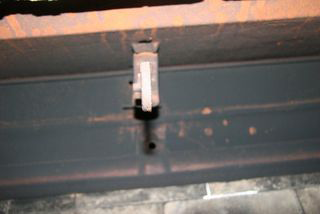
by blogediter | Mar 22, 2019 | Fireplaces
Q: Jason, I am very interested in a Chimney Balloon for my fireplace damper. I have a question that does not appear to be answered in your FAQ’s. How do you install a Chimney Balloon with a dampener handle sticking down into the firebox area? I cannot remove the handle and it would seem to be an object preventing a seal. I am sure there is an answer to this and await your reply. – DS
A: Hi DS, I don’t mean to be picky about vocabulary (It was not my strong suit in school either) but the correct word for the metal door in the fireplace is a “fireplace damper“. It is a common slip of the tongue, people call them dampers all the time.
In your particular application, I would recommend that you take your Chimney Balloon measurement above the damper opening. This location will get your Chimney Balloon up and out of the way of the damper hardware that is below the damper door.
From the picture, it looks like the damper is nice and low, but photos of flues can be deceiving in depth. If you cannot easily touch the damper door with two hands I would recommend you purchase a HEK valve extender with your Chimney Balloon to make the inflation go easier. – Jason




